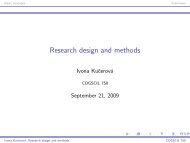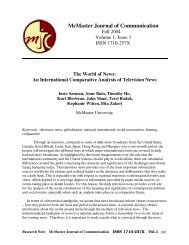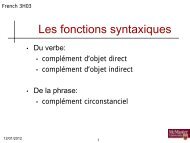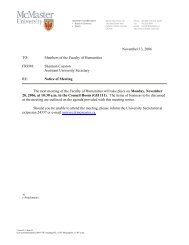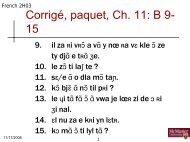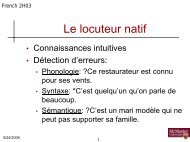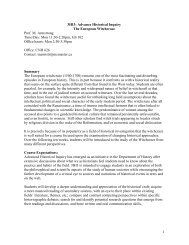The Syntax of Givenness Ivona Kucerová
The Syntax of Givenness Ivona Kucerová
The Syntax of Givenness Ivona Kucerová
Create successful ePaper yourself
Turn your PDF publications into a flip-book with our unique Google optimized e-Paper software.
Petr’s friends.Acc saw Marie.Nom and he<br />
‘*Marie and he i saw Petr’s i friends.’<br />
A.3 <strong>The</strong> Weak Cross-Over Effect<br />
Finally, let’s look at the Weak Cross-Over effect (WCO), defined in (19).<br />
(19) Weak Cross-Over:<br />
A pronoun can only be bound from an argument position.<br />
As can be seen in (20), no WCO violation arises in case <strong>of</strong> G-movement <strong>of</strong> ‘every girl’.<br />
<strong>The</strong> example in (21) is here as a control. Long-distance movement leads to a WCO violation.<br />
<strong>The</strong> contrast shown in (20) and (21) supports the argument that G-movement is<br />
A-movement because it creates new binding relations.<br />
(20) a. *Její pes miluje každou holčičku.<br />
her-i dog.Nom loves every girl.Acc-i<br />
b. Každou holčičku miluje její pes.<br />
every girl.Acc-i loves her-i dog<br />
‘Every girl is loved by her dog.’<br />
(21) *KAŽdou holčičku, chci, aby miloval její pes.<br />
every girl.Acc.TOP-i want-I that loved her-i dog<br />
‘I want every girl to be loved by her dog.’<br />
A.4 A note on base generation<br />
So far I have been assuming that the linear partition between given and new elements is<br />
achieved via movement. However, it has been suggested in the literature that elements on<br />
the left periphery that do not have A-bar properties are base generated in their surface position.<br />
This argument has been made in detail for Romance left clitic dislocation structures<br />
(Cinque 1990; Iatridou 1995; Barbosa 1995). Even though these structures show sensitivity<br />
to syntactic islands, i.e., they appear to undergo movement, the above cited authors argue<br />
that the island sensitivity is a result <strong>of</strong> the presence <strong>of</strong> a binding chain that is either entirely<br />
independent <strong>of</strong> movement, or arises from a short movement within the left periphery. One<br />
could argue that Czech G-movement is just another instance <strong>of</strong> base generation (notice<br />
that the left dislocated elements in clitic left dislocation constructions are given as well)<br />
and that the various word orders are base generated as they are. Another line <strong>of</strong> such an<br />
argument has been made in connection with scrambling by Haider (1988); Bayer and Kornfilt<br />
(1994); Kiss (1994); Neeleman (1994); Neeleman and Reinhart (1998), among others.<br />
In this section, I present two objections to a base-generation approach. <strong>The</strong> first objection<br />
is that the base generation hypothesis does not make clear predictions about the final<br />
word order and it would have to be combined with another system that would determine<br />
the final word order. We have seen in chapter 2 and 3 quite a few examples that suggest a<br />
139





